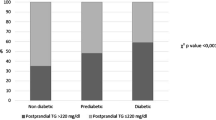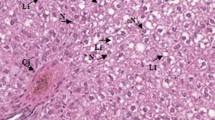Abstract
Hypertriglyceridaemia is associated with insulin resistance of both lipid and glucose metabolism. It is not known whether the insulin resistance affects both glucose oxidation and glycogen formation. To study the oxidative and non-oxidative pathways of non-esterified fatty acids (NEFA) and glucose metabolism, eight male hypertriglyceridaemic subjects were studied during insulin infusion (75 and 340 pmol/m2 · min) in combination with indirect calorimetry and infusions of [3-3H]glucose and [1-14C]palmitate before and after 4 weeks of treatment with the antilipolytic agent acipimox (250 mg three times daily). Compared with eight healthy subjects the hypertriglyceridaemic subjects were resistant to the antilipolytic effect of insulin, both in the basal state (P<0.05) and during insulin infusion (P<0.05). This was associated with impaired insulin-stimulated glucose uptake (P<0.05), predominantly in the non-oxidative pathway (P<0.05). Acipimox decreased basal NEFA concentrations (P<0.01) and reduced lipid oxidation during low-dose insulin infusion (P<0.05). Glucose uptake, predominantly glycogen formation, was stimulated by acipimox (P<0.05). In conclusion, the insulin resistance of glucose metabolism associated with hypertriglyceridaemia is largely due to a defect in non-oxidative glucose metabolism. Acipimox improves glucose metabolism both by affecting glucose oxidation (low-dose insulin) and non-oxidative glucose metabolism (high-dose insulin).
Similar content being viewed by others
References
Nikkilä EA, Taskinen M-R, Hypertriglyceridemia and insulin secretion: a complex casual relationship. In: Jones JR (ed) Atherosclerosis II. Springer, Berlin Heidelberg New York, 1970
Steiner G, Morita S, Vranic M, Resistance to insulin but not to glucagon in lean human hypertriglyceridemics. Diabetes 29:899–905, 1980
Reaven GM, Mejean L, Villaume C, Drouin P, Debry G, Plasma glucose and insulin responses to oral glucose in nonobese subjects and patients with endogenous hypertriglyceridemia. Metabolism 32:447–450, 1983
Malmendier CL, Delcroix C, Berman M, Interrelations in the oxidative metabolism of free fatty acids, glucose and glycerol in normal and hyperlipidemic patients. J Clin Invest 54:461–476, 1974
Kissebah AH, Alfarsi S, Adams PW, Seed M, Folkard J, Wynn V, Transport kinetics of plasma free fatty acid, very low density lipoprotein triglycerides and apoprotein in patients with endogenous hypertriglyceridemia; effects of 2,3-dimethyl, 5(2,5-xyloxy)valeric acid therapy. Atherosclerosis 24:199–218, 1976
Kissebah AH, Alfarsi S, Adams PW, Wynn V, Role of insulin resistance in adipose tissue and liver in the pathogenesis of endogenous hypertriglyceridemia in man. Diabetologia 12:563–571, 1976
Larsson B, Björntorp P, Holm J, Schersten T, Sjöström L, Smith U, Adipocyte metabolism in endogenous hypertriglyceridemia. Metabolism 24:1375–1389, 1975
Yki-Järvinen H, Taskinen M-R, Interrelationships among insulin's antilipolytic and glucoregulatory effects and plasma triglycerides in nondiabetic and diabetic patients with endogenous hypertriglyceridemia. Diabetes 37:1271–1278, 1988
Randle PJ, Garland PB, Hales CN, Newsholme EA, The glucose fatty-acid cycle. Its role in insulin sensitivity and the metabolic disturbances of diabetes mellitus. Lancet I:785–789, 1963
Ferrannini E, Barrett EJ, Bevilacqua S, DeFronzo RA, Effect of fatty acids on glucose production and utilization in man. J Clin Invest 72:1737–1747, 1983
Thièbaud D, DeFronzo RA, Jacot E, Golay A, Acheson K, Maeder E, Jéquier E, Felber JP, Effect of long-chain triglyceride infusion on glucose metabolism in man. Metabolism 31:1128–1136, 1982
Baron AD, Brechtel G, Edelman SV, Effects of free fatty acids and ketone bodies on in vivo non-insulin-mediated glucose utilization and production in humans. Metabolism 38:1056–1061, 1989
Bonadonna RC, Zych K, Boni C, Ferrannini E, DeFronzo RA, Time dependence of the interaction between lipid and glucose in humans. Am J Physiol 255:E49–E56, 1989
Boden G, Jadali F, White J, Liang Y, Mozzoli M, Chen X, Coleman E, Smith C, Effects of fat on insulin-stimulated carbohydrate metabolism in normal men. J Clin Invest 88:960–966, 1991
Yki-Järvinen H, Puhakainen I, Koivisto VA, Effect of free fatty acids on glucose uptake and non-oxidative glycolysis across human forearm tissues in the basal state and during insulin stimulation. J Clin Endocrinol Metab 72:1268–1277, 1991
Mandarino L, Tsalikian E, Barthold S, Marsh H, Carney A, Buerklin E, Tutwiler G, Haymond M, Handwerger B, Rizza R, Mechanism of hyperglycemia and response to treatment with an inhibitor of fatty acid oxidation in a patient with insulin resistance due to antiinsulin receptor antibodies. J Clin Endocrinol Metab 59:658–664, 1984
DeFronzo RA, Tobin JD, Andres R, Glucose clamp technique: a method for quantifying insulin secretion and resistance. Am J Physiol 237:E214–223, 1979
Ferrannini E, The theoretical basis for indirect calorimetry: a review. Metabolism 37:287–301, 1988
Meriläinen PT, Metabolic monitor. Int J Clin Monit Comput 4:167–177, 1987
Tappy L, Owen OE, Boden G, Effect of hyperinsulinemia on urea pool size and substrate oxidation rates. Diabetes 37:1212–1216, 1988
Taskinen M-R, Nikkilä EA, Effects of acipimox on serum lipids, lipoproteins and lipolytic enzymes in hypertriglyceridemia. Atherosclerosis 69:249–255, 1988
Miles JR, Glasscock J, Aikens J, Gerich J, Haymond M, A microfluorometric method for the determination of free fatty acids in plasma. J Lipid Res 24:96–99, 1983
Taskinen M-R, Bogardus C, Kennedy A, Howard BV, Multiple disturbances of free fatty acid metabolism in non-insulin-dependent diabetes. Effect of oral hypoglycemic therapy. J Clin Invest 76:637–644, 1985
Dole VP, A relation between non-esterified fatty acids in plasma and the metabolism of glucose. J Clin Invest 35:150–154, 1956
Radziuk J, Norwich KH, Vranic M, Experimental validation of measurements of glucose turnover in nonsteady state. Am J Physiol 234:E84–E93, 1978
Steele R, Influences of glucose loading and of injected insulin on hepatic glucose output. Ann J Acad Sci 82:420–430, 1959
Shulman GI, Rothman DL, Jue T, Stein P, DeFronzo RA, Shulman RG, Quantitation of muscle glycogen synthesis in normal subjects and subjects with non-insulin-dependent diabetes by (+13)C nuclear magnetic resonance spectroscopy. N Engl J Med 322:223–228, 1990
Hagenfeldt L, Wahren J, Pernow B, Räf L, Uptake of individual free fatty acids by skeletal muscle and liver in man. J Clin Invest 51:2324–2330, 1972
Miles JM, Ellman MG, McLean KL, Jensen MD, Validation of a new method for determination of turnover of free fatty acid. Am J Physiol 252:E431–E438, 1987
Hagenfeldt L, Turnover of individual free fatty acids in man. Fed Proc 34:2246–2249, 1975
Issekutz B Jr, Bortz WM, Miller HI, Paul P, Turnover rate of FFA in humans and in dogs. Metab Clin Exp 16:1001–1009, 1967
Waterhouse C, Baker N, Rostami H, Effect of glucose ingestion on the metabolism of free fatty acids in human subjects. J Lipid Res 10:487–489, 1969
Grundy SM, Vega GL, Hypertriglyceridemia: causes and relation to coronary heart disease. Semin Thromb Hemost 14:149–164, 1988
Kissebah AH, Adams PW, Wynn V, Inter-relationship between insulin secretion and plasma free fatty acid and triglyceride transport kinetics in maturity onset diabetes and the effect of phenethylbiguanide (phenformin). Diabetologia 10:119–130, 1974
Reaven GM, Banting lecture 1988. Role of insulin resistance in human disease. Diabetes 37:1595–1607, 1988
Karpe F, Olivecrona T, Walldius G, Hamsten A, Lipoprotein lipase in plasma after an oral fat load: relation to free fatty acids. J Lipid Res 33:975–984, 1992
Brunzell JD, Porte D, Bierman EL, Abnormal lipoprotein lipase mediated plasma triglyceride removal in untreated diabetes mellitus associated with hypertriglyceridemia. Metabolism 28:901–907, 1979
Widén E, Ekstrand A, Saloranta C, Franssila-Kallunki A, Eriksson J, Schalin-Jäntti C, Groop L, Insulin resistance in type 2 (non-insulin-dependent) diabetic patients with hypertriglyceridaemia. Diabetologia 35:1140–1145, 1992
Bieger WP, Michel G, Barwich D, Bhiel K, Wirth A, Diminished insulin receptors on monocytes and erythrocytes in hypertriglyceridemia. Metabolism 33:982–987, 1984
Shen D-C, Fuh MTT, Shieh S-M, Chen Y-D, Reaven GM, Effect of gemfibrozil treatment in sulfornylurea-treated patients with non-insulin-dependent diabetes mellitus. J Endocrinol Metab 73:503–510, 1991
Vuorinen-Markkola H, Yki-Järvinen H, Taskinen M-R, Lowering of triglycerides by gemfibrozil affects neither the glucoregulatory nor antilipolytic effect of insulin in type 2 (non-insulin-dependent) diabetic patients. Diabetologia 36:161–169, 1993
Steiner G, Altering triglyceride concentrations changes insulin-glucose relationships in hypertriglyceridemic patients. Doubleblind study with gemfibrozil with implications for atherosclerosis. Diabetes Care 14:1077–1081, 1991
Piatti PM, Monti LD, Baruffaldi L, Magni F, Santambrogio G, Nasser R, Marchi M, Pontiroli AE, Influence of hypertriglyceridemia on glucose metabolism in man. Diabetes 42 (Suppl 1): 755, 1993
Lovisolo PP, Briatico-Vangosa G, Orsini G, Ronchi R, Angelucci R, Valzelli G, Pharmacological profile of a new antilipolytic agent: 5-methyl-pyrazine-2-carboxylic acid-4-oxide (acipimox). I. Mechanisms of action. Pharmacol Res Comm 13:151–161, 1981
Fulcher GR, Walker M, Farrer M, Johnson AS, Alberti KGMM, Acipimox increases glucose disposal in normal man independent of changes in plasma nonesterified fatty acid concentration and whole-body lipid oxidation rate. Metabolism 42:308–314, 1993
McKane WR, Stevens AB, Woods R, Andrews WJ, Henry RW, Bell PM, The assessment of hepatic and peripheral insulin sensitivity in hypertriglyceridemia. Metabolism 39:1240–1245, 1990
Bevilaqua S, Bonadonna RC, Boni C, Ciociaro D, Maccari F, Giorico MA, Ferrannini E, Acute elevation of free fatty acid levels leads to hepatic insulin resistance in obese subjects. Metabolism 36:502–506, 1987
Fulcher GR, Walker M, Catalano C, Agius L, Alberti KGMM, Metabolic effects of suppression of non-esterified fatty acid levels with acipimox in obese NIDDM subjects. Diabetes 41:1400–1408, 1992
Saloranta C, Franssila-Kallunki A, Ekstrand A, Taskinen MR, Groop LC, Modulation of hepatic glucose production by non-esterified fatty acids in type 2 (non-insulin-dependent) diabetes mellitus. Diabetologia 34:409–415, 1991
Vaag AA, Beck-Nielsen H, Effects of prolonged acipimox treatment on glucose and lipid metabolism and on in vivo insulin sensitivity in patients with non-insulin-dependent diabetes mellitus. Acta Endocrinol 127:344–350, 1992
Jenssen T, Nurjhan N, Consoli A, Gerich JE, Failure of substrate-induced gluconeogenesis to increase overall glucose appearance in normal humans. Demonstration of hepatic autoregulation without a change in plasma glucose concentration. J Clin Invest 86:489–497, 1990
Puhakainen I, Koivisto VA, Yki-Järvinen H, No reduction in total hepatic glucose production by inhibition of gluconeogenesis with ethanol in NIDDM patients. Diabetes 40:1319–1327, 1991
Kubota M, Virkamäki A, Yki-Järvinen H, Ethanol stimulates glycogenolysis in livers from fed rats. Proc Soc Exp Biol Med 201:114–118, 1992
Belle M, Halpern MM, Oral nicotinic acid for hyperlipemia—with emphasis on side effects. Am J Cardiol 2:449, 1958
Molnar GD, Berge KG, Rosevear JW, McGuckin WF, Achor RWP, The effect of nicotinic acid in diabetes mellitus. Metabolism 13:181–189, 1964
Garg A, Grundy SM, Nicotinic acid as therapy for dyslipidemia in non-insulin-dependent diabetes mellitus. JAMA 264:723–726, 1990
Gurian H, Adlersberg D, The effect of large doses of nicotinic acid on circulating lipids and carbohydrate tolerance. Am J Med Sci 237:12, 1959
Author information
Authors and Affiliations
Rights and permissions
About this article
Cite this article
Saloranta, C., Groop, L., Ekstrand, A. et al. The effect of an antilipolytic agent (acipimox) on the insulin resistance of lipid and glucose metabolism in hypertriglyceridaemic patients. Acta Diabetol 31, 6–13 (1994). https://doi.org/10.1007/BF00580753
Received:
Accepted:
Issue Date:
DOI: https://doi.org/10.1007/BF00580753




